Alienware M11x R2: A Legend Reborn
by Jarred Walton on July 9, 2010 4:05 AM ESTApplication Performance: Arrandale ULV beats OCed CULV
While the gaming performance was generally a wash, application performance shows some clear improvements. Granted, we have the more expensive model with an i7-640UM instead of the i5-520UM, so besides a 133MHz higher base clock it also comes with Turbo Boost that up to 333MHz faster. Subjectively, the M11x R2 feels plenty fast, though the use of a conventional hard drive makes it less snappy than it otherwise could be. In fact, the R2 takes longer to boot than most other laptops, clearly hindered by the various Alienware applications that control the lighting and other features. Once in Windows, though, things settle down and the laptop runs well, launching applications and games noticeably faster than CULV laptops. We ran through our standard application benchmarks just to confirm our impression.
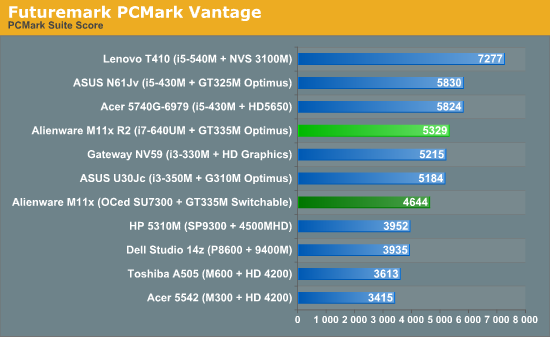
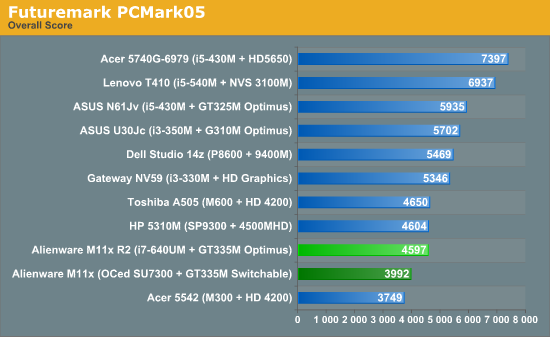

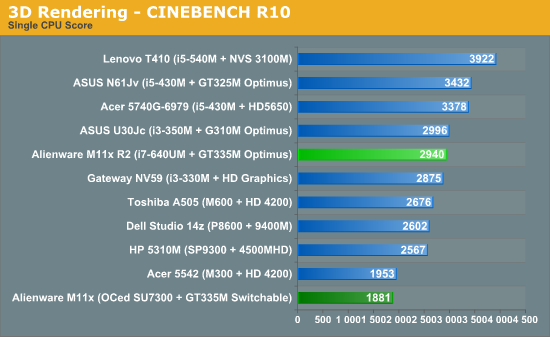
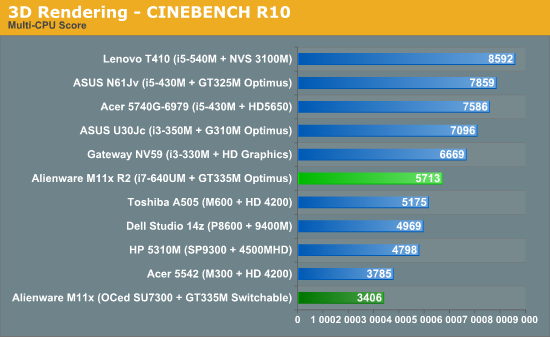
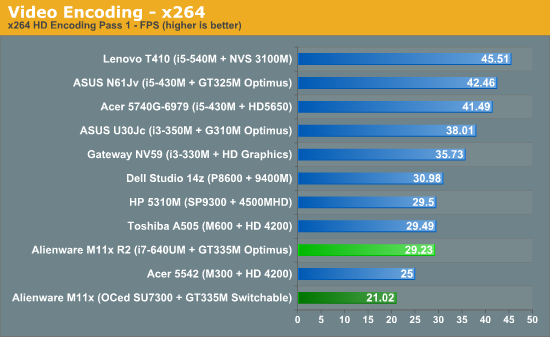
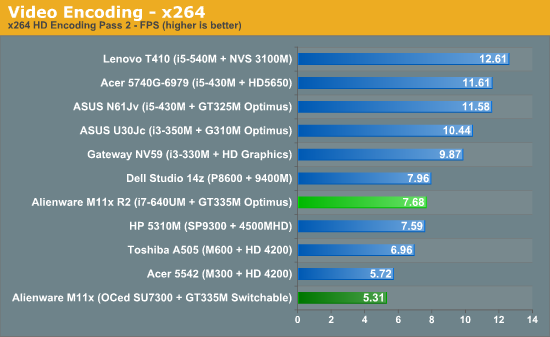
Both PCMark results improve by 15%, but they're at the lower end of the improvement scale. Peacekeeper shows the benefit of Turbo Boost, with 51% faster scores on the R2. Likewise, Cinebench is 56% faster on the 1CPU test, and Hyper-Threading plus Turbo Boost improve the multi-core rendering score by 68%. Rounding things out, x264 encoding also benefits from HTT and Turbo modes, with 39% and 45% faster encoding in pass one and two respectively. If you opt for the standard i5-520UM model, we expect scores will drop at least 10%, and perhaps as much as 20%, so keep that in mind.
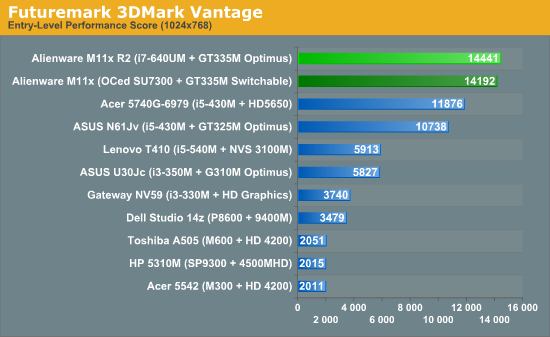
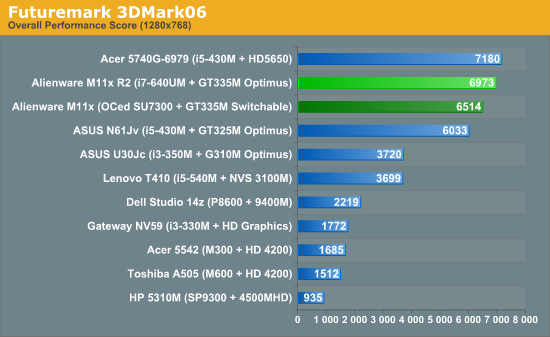
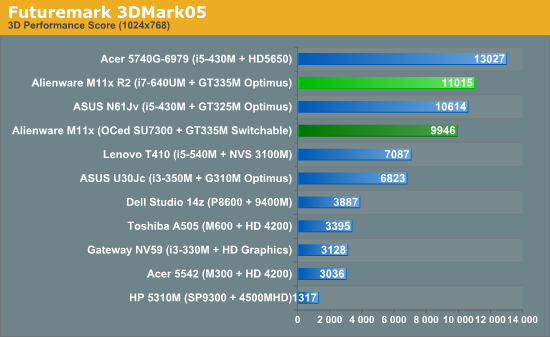
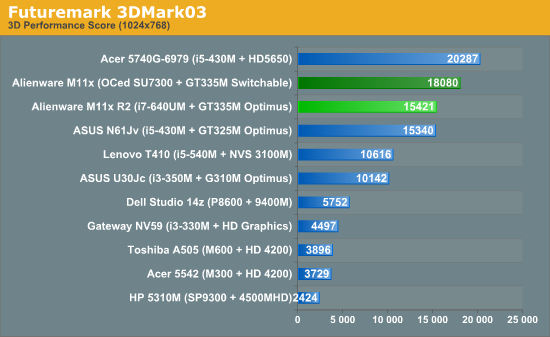
A quick look at 3DMark results confirms our gaming scores. 05, 06, and Vantage all have the R2 leading by a small amount—11%, 7%, and 2% respectively. Meanwhile, again we have a situation where an older application with higher frame rates runs slower on the R2. 3DMark03 is 17% faster on the original M11x, and while we don't "play" 3DMark it suggests that the process of transferring frames over the PCI-E bus to the IGP frame buffer is likely limiting performance. If you recall, Optimus doesn't have any direct connections to the displays, letting all of those go through the IGP. It's what allows the instantaneous switch between IGP and dGPU with no screen flicker. The catch is that all the frames go over the PCI-E bus. That's not a problem when you run at reasonable settings and get frame rates of under 60FPS, as you're only looking at around 250MB/s of data on a bus capable of handling 8000MB/s. However, theoretical performance and practical performance are different matters, and with the game tests on 3DMark03 running at anywhere from 110 to 350 FPS congestion seems likely.
We looked at the detailed results for 3DMark03, and sure enough it's the Game 1 test that shows the biggest drop. On the original it ran at 348FPS while it gets just 179FPS on the R2. The other results are closer; Game 2 runs at 136 vs. 128, Game 3 at 112 vs. 110, and Game 4 at 135 vs. 108—with the R1 beating the R2 in all four tests. This also appears to confirm that the lower scores in our Empire: Total War and STALKER: Call of Pripyat games (at minimum detail where frame rates are high) are not a driver issue so much as a PCI-E congestion issue. Again, this isn't a problem when you're playing games at reasonable frame rates (you don't really need more than 60FPS on typical LCDs), but we found it interesting nonetheless.










55 Comments
View All Comments
dumpsterj - Friday, July 9, 2010 - link
ive got one on order and i cant wait for it. im glad the battlefield benchmarks saw such an improvement , as thats one reason i decided to replace my old asus f3sv w/ its 8600gs. It cant play bf 2 for crap. thanks for the awesome review. i know what to expect but im still happy im getting it. when i get it ill update in the comments.Mark McGann - Friday, July 9, 2010 - link
Does anyone know if the SSD option for this laptop supports TRIM?I've never been able to find any definitive information on this, which leads me to believe it doesn't.
JarredWalton - Friday, July 9, 2010 - link
Pretty sure the 256GB SSD is a Samsung model, and if it's one of the newer ones it supports TRIM. But honestly, I would NOT pay the outrageous $600 upgrade price to get it pre-installed. You can buy a 256GB for $525 online if you really want to:http://www.newegg.com/Product/Product.aspx?Item=N8...
Better still, if you really want an SSD and are willing to pay for it, get an SSD that's worth having, like the RealSSD C300 from Crucial or a SandForce SSD. $600 for the Samsung drive from Dell, or $600 for a 240GB SandForce 1200 SSD, or even $640 for the 256GB C300. I think the choice is clear:
http://www.newegg.com/Product/Product.aspx?Item=N8...
http://www.newegg.com/Product/Product.aspx?Item=N8...
Friendly0Fire - Friday, July 9, 2010 - link
Of all the review, what piqued my interest the most is the mention of a new U30Jc with a better GPU... Where did you hear that rumor? Any details on it? Honestly the M11x R2 is a nice laptop but I just don't really like the aesthetics and the screen size. A U30Jc with a GT335M or above would be the ideal laptop.JarredWalton - Friday, July 9, 2010 - link
Not a rumor... it's what we *want* to see. Will ASUS make that? I hope so, but right now it looks like the U series is still getting saddled with G310M. :-\MaxGeek - Friday, July 9, 2010 - link
I'm a M11x R2 owner and one thing I ran into is that the NVidia GPU throttling is sometimes broken. The GPU is suppose to be 450MHZ, but often it will only throttle up to 405MHZ from 135MHZ even when plugged in and gaming. This can cost you a fair amount of performance. This is an app out there called PowerMizer Manager that can fix this.Also as far as overclocking I've found it to be pretty significant. Once the system gets decently hot from gaming Intel Turbo boost won't kick in, so overclocking ensures you get consistent performance. Combined with GPU overclock, overclocking the CPU adds additional performance over a GPU overclock at stock CPU speeds. I found that Resident Evil 5 is also CPU limited and GPU overclocking didn't improve performance until the CPU was also overclocked.
MaxGeek - Friday, July 9, 2010 - link
Sorry for the Engrish, I can't edit my post...Roland00 - Friday, July 9, 2010 - link
I am glad for smaller gaming computers, but I rather have one of these. Add 3/4 lb of weight and 1 inch bigger; and in return you get faster, cheaper, and with an optical drive. All for 3/4 of a lbASUS K42JV-X1
I5-450m 2.4 GHZ, Nvidia GT335m, 4 GB RAM, 500 GB HD, DVD Burner, 1366x768, 4400mAH, 14 Inch, 4.8 lbs, $949
http://www.newegg.com/Product/Product.aspx?Item=N8...
AS4820TG-3195 (Acer Timeline X)
I5-450m 2.4 GHZ, ATI HD5650, 4 GB RAM, 500 GB HD, DVD Burner, 1366x768, 6000mAH, 14 Inch, 4.9 lbs, $899
http://www.microcenter.com/single_product_results....
JarredWalton - Friday, July 9, 2010 - link
We should be getting the N82Jv in the near future (as soon as it shows up in the US). It's basically the same as the K42Jv you just listed, except with an 84Wh battery. That's the only downfall with the current K42: 48Wh battery means 3-4 hours battery life.erple2 - Saturday, July 10, 2010 - link
Interesting... Are you all also getting any of the hp Envy's (including the "new" 5830 Envy 15)?